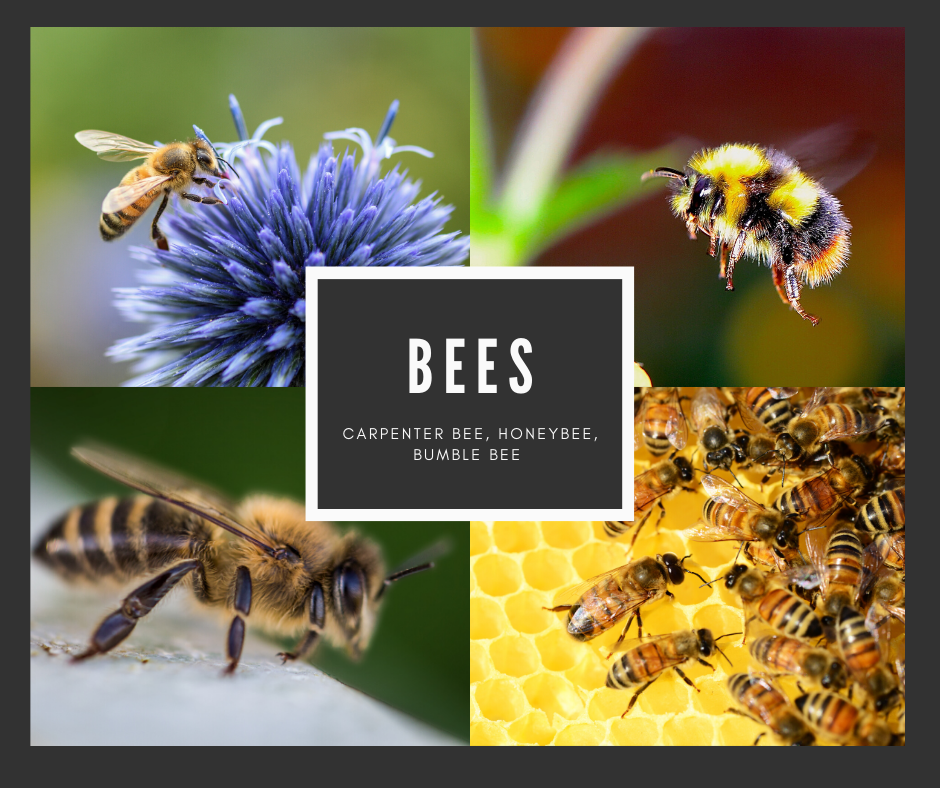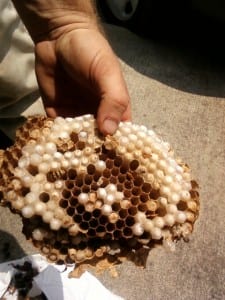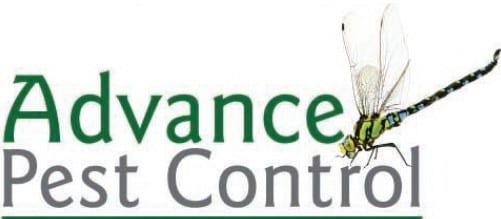All the April rain bring May flowers. And, bugs! As the weather becomes nicer and warmer we are able to venture out a little more than we have in what seems forever. This time of year we’re all seeing more bugs and insects hanging around our homes, inside and outside. It is normal. But who wants to be bothered by them? With the blooming of flowers, planting of crops and sunshine the bees, wasps and hornets are becoming much more active. Plus, with all the pretty weather ahead of us we are venturing out more and more which also means we can potentially disturb the nests of these stinging insects in our yard.

The bees, wasps and hornets may cause deathly allergic stings or very painful stings if they are agitated enough. So, let’s dive into the varieties of these stinging insects:

BEES – There are several types of bees with the most common being honeybees, bumblebees, and carpenter bees. These types of bees tend to not be aggressive and less likely to sting.
Honeybees – Who doesn’t love a honeybee! They are a vital part of our world. Without these pollinators we would have fewer beautiful flowers (and, crops!) to grace our eyes and fill the air with wonderful fragrances. Honeybees typically live in hollow trees or walls where they create delicious honey we love to consume. These bees tend to not be aggressive at all unless they feel to be in grave danger. So, leave the honeybee alone and it will leave you alone.
Bumble Bees – When you think of springtime, the hum of a bee is usually a part of that vision. It’s the bumble bee we all associate springtime with. These bees live in nests above ground or on elevated sources. Bumble bees are an essential part of pollinating our flowers just like the honeybee.
Carpenter Bees – Oh what fun these bees are! Carpenter bees love chewing on wood and boring their homes in old wood surfaces. If you seeing wood shavings on your porch or ground, look up and around. You’ll find a small hole or two where these bees have settled. They are more likely to cause structure damage/weakening than stinging you.
So, what about wasps? Wasps are not essential for pollination but they are essential for insect control. Wasps are the next level of bees – they are aggressive and can have a powerful punch with their sting. Plus, they can sting you more than once. OUCH! There are a variety of wasps out there but these are the most common for us:

Mud Dauber Wasp – Whether you call it a dirt dauber or a mud dauber both are the same insect. You can easily identify these nests by their small, vertical size made of mud on the side of your home or structure. If you threaten these guys, they will attack but otherwise will leave you alone.
European Hornet – These hornets can be mistaken for honeybees only they are larger in size. European hornets are not the easiest type of wasps to be removed due to the fact they are active throughout the day and night. Most bees/wasps/hornets are most active during the night time.
Bald-Faced Hornet – These are the VERY aggressive of hornets meaning they will attack at the slightest noise, vibration or change in its surroundings. Bald-faced hornets are such as their name says – fully smooth body. The nest in the photo here shows a great example of their nest made of chewed and spit out wads of paper/wood/etc. Don’t play with a bald-faced hornet. You will lose! Unless it’s super cold and they are inactive.
And, lastly, we have Yellowjackets – These wasps are the most aggressive of them all. You will see these wasps more during the summer months around trash cans and picnic areas. They tend to build their nests underground so be careful where you step in your yard or park this spring and summer.
How to avoid getting stung:
Shoo “fly”: Our initial reaction to seeing bees or wasps flying around ourselves is to swat at them. DON’T DO IT! Swatting at them will make them even more agitated and potentially stinging you. You want to stay still if you become of interest to them.
If they land on you and decide to hang out, stay calm and give them a little blow. It acts like a breeze to bees and wasps that will whisk them away.
Limit your scents: Don’t attract bees and wasps with floral scents or patterns. Your perfume might be the greatest attraction to these stinging insects. Or your beautiful flower patterned top! If you’re going to be outside enjoying the sunshine remember it’s better to choose a less fragrant perfume or lotion and keep your clothing color choices neutral.
Cover up!: If you are planning to be outside for an extended period of time choose clothing that covers your arms, legs and feet. Having the least amount of skin showing deters the attraction of bees and wasps.
Cover your food!: This one should be simple to remember. No one wants to attract bugs or insects to their picnic. Always have a lid or covering of some sort for your dishes when dining outside. Sugar, jams, sodas, and anything sweet will quickly attract bees and wasps. Try to remember to limit your desserts and always make sure to have them covered.

The overall rule to avoiding stinging insects is to avoid attracting them! Just remember bees, wasps and hornets definitely serve a purpose in our environment even if we don’t like them. Our technicians are able to remove the nests and hives respectfully with the least amount of friction to help ensure your safety and theirs. While nest and hive removal can be a DIY project, you’ll want to call a professional. We can treat the hive or nest as well as remove it from your property safely.
Call or email us for pricing and scheduling!
Office: 919-569-0555 | Email: customerservice@advancepestcontrol.co

Recent Comments